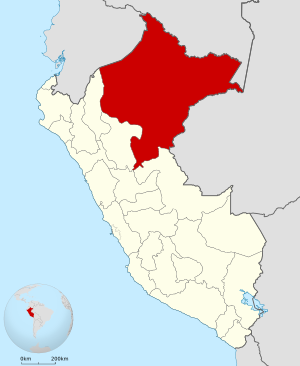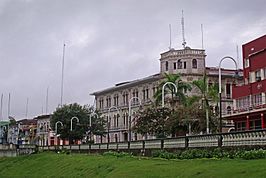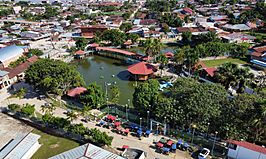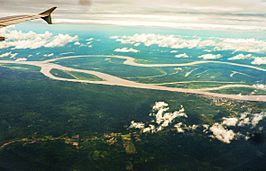Department of Loreto facts for kids
Quick facts for kids
Department of Loreto
|
|||
|---|---|---|---|
|
From top to bottom and left to right: Tree houses for tourists, Bora community dancing, a jaguar at the zoo, Iquitos's riverside boulevard, a tourist cruise, ancient rock carvings (petroglyphs), Sapi Sapi lagoon, hot springs, an Amazon ferry, and where the Marañón and Ucayali rivers meet to form the Amazon River.
|
|||
|
|||

Location of the Department of Loreto in Peru
|
|||
| Country | Peru | ||
| Subdivisions | 8 provinces and 53 districts | ||
| Established | 1853 | ||
| Capital | Iquitos | ||
| Area | |||
| • Total | 368,851.95 km2 (142,414.53 sq mi) | ||
| Highest elevation | 220 m (720 ft) | ||
| Lowest elevation | 70 m (230 ft) | ||
| Population
(2023)
|
|||
| • Total | 1,027,559 | ||
| • Density | 2.7858305/km2 (7.215268/sq mi) | ||
| Demonym(s) | Loretan | ||
| UBIGEO |
16
|
||
| Dialing code | 065 | ||
| ISO 3166 code | PE-LOR | ||
| Principal resources | Rice, cassava, wood, fruit trees, rubber and cebu cattle | ||
| Poverty rate | 24.9% | ||
| Percentage of Peru's GDP | 2.51% | ||
| Website | www.regionloreto.gob.pe | ||
Loreto is the largest and northernmost region in Peru. It covers almost one-third of Peru's total land. This makes Loreto bigger than countries like Japan! It is also one of the least crowded regions. This is because it is deep inside the Amazon Rainforest. The capital city of Loreto is Iquitos.
Contents
Where is Loreto Located?
Loreto shares borders with several countries and other regions in Peru.
- To the northwest, it borders Ecuador.
- To the north and northeast, it borders Colombia.
- To the east, it borders Brazil.
- To the south, it borders the Ucayali and Huánuco regions of Peru.
- To the west, it borders the San Martín and Amazonas regions of Peru.
Loreto's huge area is mostly covered by thick vegetation. It includes parts of both the high and low jungle.
What is the Land Like?
The land in Loreto has wide plains next to rivers. These areas often get covered with rainwater. They can be swampy during the summer. Some higher spots called restingas stay above water even when rivers swell. There are also many lagoons, known as cochas and tipishcas. These are surrounded by marshy areas with lots of grass.
Many rivers flow through Loreto. All of them are part of the Amazon River system. Most of these rivers are easy to travel on by boat. The main river is the Amazon. It is one of the most important rivers in the world. Its many curves are always changing. Sometimes, this makes travel difficult. The Amazon River can be as wide as 4 km (2.5 mi) between its banks! Other important rivers include the Yavari River, Putumayo, Ucayali, and Marañón.
What is the Climate Like?
Loreto has a warm and humid climate. The average temperature is about 17 °C (63 °F) to 20 °C (68 °F) in June and July. It can get as hot as 36 °C (97 °F) from December to March.
The air is usually very humid, around 84%. It rains a lot throughout the whole year.
How is Loreto Organized?
The Loreto region is divided into eight main areas called provinces. Each province has its own capital city. These provinces are then split into smaller areas called districts.
Here are the eight provinces and their capital cities:
- Alto Amazonas (capital: Yurimaguas)
- Datem del Marañón (capital: San Lorenzo)
- Loreto (capital: Nauta)
- Mariscal Ramón Castilla (capital: Caballococha)
- Maynas (capital: Iquitos)
- Requena (capital: Requena)
- Ucayali (capital: Contamana)
- Putumayo (capital: San Antonio del Estrecho)
What are the Biggest Cities?
Here are the most populated cities in Loreto:
| # | City | Population |
|---|---|---|
| 1 | Iquitos |
|
| 2 | Yurimaguas |
|
| 3 | Nauta |
|
| 4 | Requena |
|
A Look at Loreto's History
The first people to live in this region spread out from the eastern slopes of the Andes mountains. Many of these ethnic groups settled along the Purús, Turúa, and Yaraví rivers.
It's hard to know exactly how many indigenous peoples lived here when the first European explorers arrived. Records from that time suggest that about 100,000 native people were baptized in the first century of contact. It's thought that the total population was around 300,000 when the Spanish first came. Sadly, many native people later got sick from diseases like smallpox, malaria, and yellow fever because of contact with the Spanish.
Discovery of the Amazon River
On February 12, 1542, a Spanish explorer named Francisco de Orellana discovered the Amazon river. This amazing journey started in the mountains and took several months of searching.
Founding of Iquitos
Even though people had started settling here decades earlier, the city of Iquitos was officially founded in the 1750s. It is located between the Nanay River and the Amazon River. This spot was perfect for starting journeys to nearby areas.
Colonial Times and Missions
During the time of Spanish rule, religious groups like the Jesuits and Franciscans came to Loreto. They taught Christianity and founded many towns. They also helped by creating travel routes. This made it easier to connect different indigenous groups and colonial villages.
After these missions ended, Loreto was largely forgotten by the rest of the country for most of the 1800s. However, this period still laid the groundwork for how the region would be governed later. It also saw the start of steamboat travel, the rise of the rubber industry, and people moving in from other countries.
The Rubber Boom
The "Golden Age" of Iquitos began in the late 1800s with the rubber boom. Rubber became very valuable, and Loreto had a lot of it. This made the region a center of attention and desire around the world. This busy time lasted for about 25 years. It brought a lot of development to Loreto, even after the rubber boom ended.
In 1853, the Littoral Province of Loreto was created. This area included what are now the Ucayali and San Martín regions, plus parts of Ecuador and Colombia.
Who Lives in Loreto?
Loreto is home to many Amazonian indigenous peoples. Some of these groups include the Amhuacas and the Urarina.
What Languages are Spoken?
According to the 2007 Peru Census, most people in Loreto speak Spanish as their first language (92.51%). However, many other native languages are also spoken.
Here's a look at the main languages spoken in each province:
| Province | Quechua | Aymara | Asháninka | Another native language | Spanish | Foreign language | Deaf or mute | Total |
|---|---|---|---|---|---|---|---|---|
| Alto Amazonas | 367 | 16 | 15 | 12,811 | 81,928 | 7 | 146 | 95,290 |
| Datem del Marañón | 1,736 | 13 | 8 | 20,014 | 22,329 | 1 | 43 | 44,144 |
| Loreto | 548 | 9 | 8 | 4,618 | 50,795 | 1 | 79 | 56,058 |
| M. Ramón Castilla | 497 | 30 | 13 | 4,411 | 44,083 | 38 | 44 | 49,116 |
| Maynas | 2,612 | 140 | 80 | 4,466 | 446,809 | 266 | 427 | 454,800 |
| Requena | 29 | 6 | 16 | 1,449 | 57,561 | - | 64 | 59,125 |
| Ucayali | 101 | 15 | 24 | 5,748 | 49,835 | 5 | 55 | 55,783 |
| Total | 5,890 | 229 | 164 | 53,517 | 753,340 | 318 | 858 | 814,316 |
| % | 0.72 | 0.02 | 0.03 | 6.57 | 92.51 | 0.04 | 0.11 | 100.00 |
What is Loreto's Culture Like?
Festivities and Celebrations
Loreto has many fun traditions and celebrations throughout the year:
- First week of January: This week celebrates the anniversary of Iquitos, the capital city. There are many festivities to mark the city's founding.
- Third week of February: People enjoy lively carnivals.
- June 24: This is the Fiesta de San Juan (Saint John's Festival). Locals go to the banks of the Nanay and Amazon rivers. They bring traditional juanes (a dish cooked the night before). Everyone drinks, dances, and has a great time by the water.
- First two weeks of August: A fair for farms, livestock, and crafts takes place. It's held in Santa Clara de Nanay, a small town about 14 kilometres (8.7 mi) from Iquitos.
- September 7: This day honors Señora de la Natividad. The people of Tamshiyacu in the Maynas province celebrate their patron saint.
- December 8: The Fiesta de la Purísima is celebrated. This happens in the Punchana district, about 3 kilometres (1.9 mi) from Iquitos.
What Foods and Drinks are Popular?
The food in Loreto is similar to other parts of the Amazon region.
- Motelo is a soup made from turtle meat.
- Juanes are like tamales made with rice, chicken, or fish. These are very popular Loretan dishes.
- In local markets, you might find fried or steamed monkey or lizard meat. Locals consider these very tasty.
Other common dishes include:
- Cecina: Dried and smoked pork.
- Tacacho: Bananas cooked over coals, mixed with pork and chopped onions.
- Chonta salad.
- Palometa: A type of fish soup.
- Carachama: Another type of fish.
- Paiche: A very large fish.
For desserts, a refreshing aguaje ice cream is a favorite.
To drink, people often have masato. This is a beer made from cassava (a root vegetable). They also enjoy natural fruit juices. Popular fruit juices include aguaje, maracuyá (passion fruit), and cocona (a type of fruit).
Places to Visit
Loreto has amazing natural areas to explore:
- Allpahuayo-Mishana National Reserve
- Pucacuro Reserved Zone
- Pacaya-Samiria National Reserve
See also
 In Spanish: Departamento de Loreto para niños
In Spanish: Departamento de Loreto para niños













